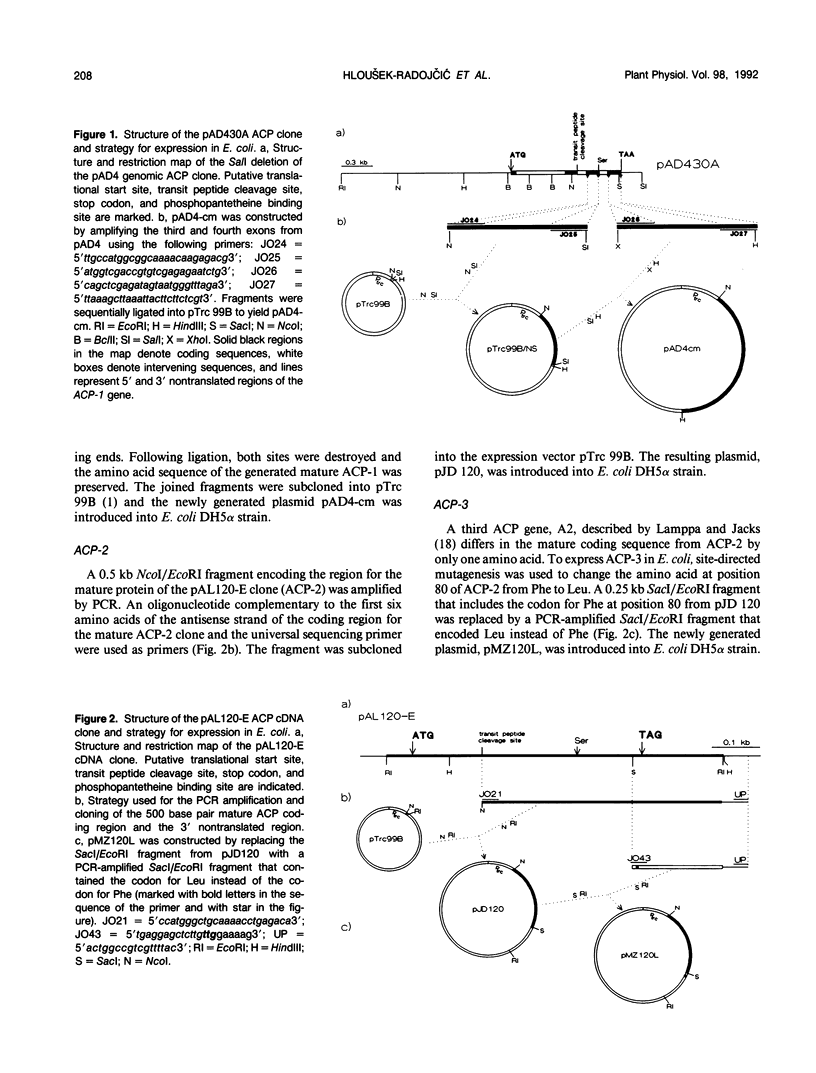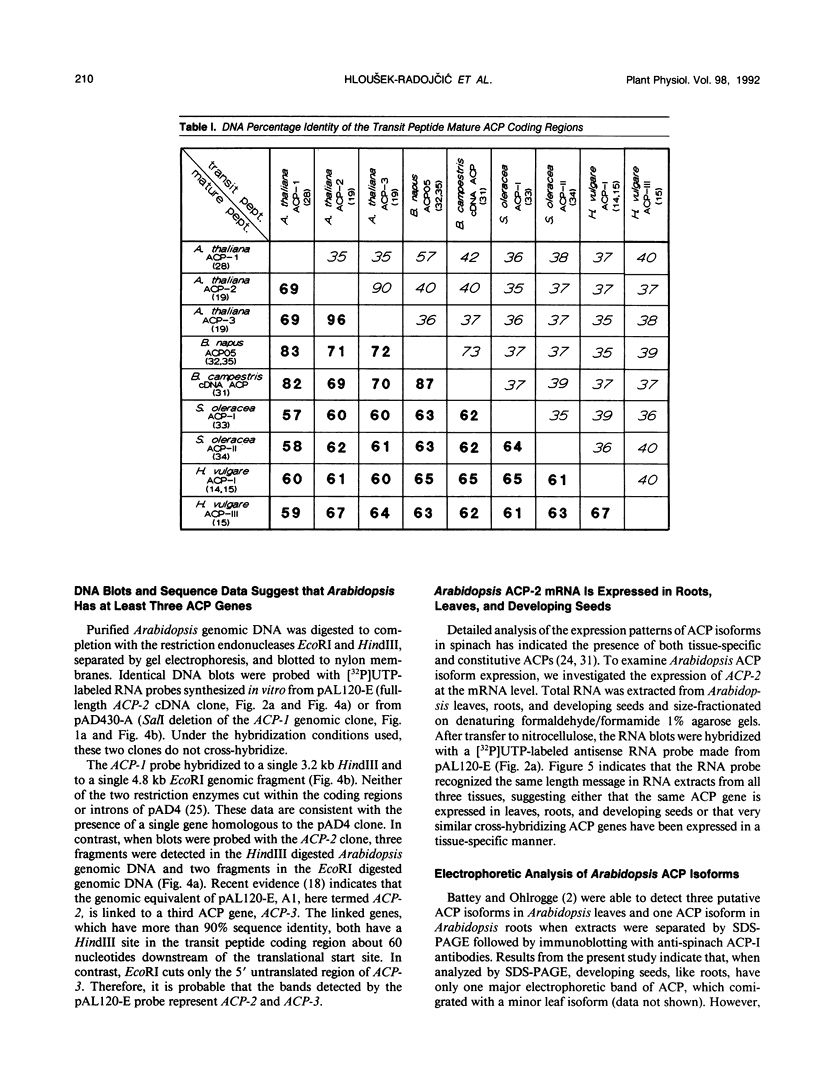Abstract
We have characterized the occurrence and expression of multiple acyl carrier protein (ACP) isoforms in Arabidopsis thaliana (L.) Heynh ecotype Columbia. Immunoblot analysis of ACPs from Arabidopsis tissues separated by native polyacrylamide gel electrophoresis and 1 molar urea polyacrylamide gel electrophoresis revealed a complex pattern of multiple ACP isoforms. All tissues examined (leaves, roots, and seeds) expressed at least three forms of ACP. The immunoblot identifications of ACP bands were confirmed by acylation of ACP extracts with Escherichia coli acyl-ACP synthetase. A full-length cDNA clone has been isolated that has 70% identity with a previously characterized Arabidopsis genomic ACP clone (ACP-1) (MA Post-Beittenmiller, A Hloušek-Radojčić, JB Ohlrogge [1989] Nucleic Acids Res 17: 1777). Based on RNA blot analysis, the cDNA clone represents an ACP that is expressed in leaves, seeds, and roots. In order to identify the protein products of each known ACP gene, their mature coding sequences have been expressed in E. coli. Using polymerase chain reactions, exons II and III of the genomic ACP-1 clone and the mature coding sequences of the ACP-2 cDNA clone were subcloned into E. coli expression vectors. Site-directed mutagenesis was used to convert the amino acid sequence of the ACP-2 cDNA clone to that of the A2 clone of Lamppa and Jacks ([1991] Plant Mol Biol 16: 469-474), ACP-3. The three E. coli-expressed proteins have different mobilities on polyacrylamide gel electrophoresis gels and each comigrates with a different Arabidopsis ACP isoform expressed in leaves, seeds, and roots. Thus, all of the three cloned ACPs appear to be constitutively expressed Arabidopsis ACPs. In addition to these three ACP isoforms, protein blots indicate that seed, leaf, and root each express one or more tissue-specific isoforms.
Full text
PDF








Images in this article
Selected References
These references are in PubMed. This may not be the complete list of references from this article.
- Amann E., Ochs B., Abel K. J. Tightly regulated tac promoter vectors useful for the expression of unfused and fused proteins in Escherichia coli. Gene. 1988 Sep 30;69(2):301–315. doi: 10.1016/0378-1119(88)90440-4. [DOI] [PubMed] [Google Scholar]
- Beremand P. D., Hannapel D. J., Guerra D. J., Kuhn D. N., Ohlrogge J. B. Synthesis, cloning, and expression in Escherichia coli of a spinach acyl carrier protein-I gene. Arch Biochem Biophys. 1987 Jul;256(1):90–100. doi: 10.1016/0003-9861(87)90428-0. [DOI] [PubMed] [Google Scholar]
- Berger S. L. Quantifying 32P-labeled and unlabeled nucleic acids. Methods Enzymol. 1987;152:49–54. doi: 10.1016/0076-6879(87)52009-2. [DOI] [PubMed] [Google Scholar]
- Brody S., Mikolajczyk S. Neurospora mitochondria contain an acyl-carrier protein. Eur J Biochem. 1988 Apr 15;173(2):353–359. doi: 10.1111/j.1432-1033.1988.tb14005.x. [DOI] [PubMed] [Google Scholar]
- Chuman L., Brody S. Acyl carrier protein is present in the mitochondria of plants and eucaryotic micro-organisms. Eur J Biochem. 1989 Oct 1;184(3):643–649. doi: 10.1111/j.1432-1033.1989.tb15061.x. [DOI] [PubMed] [Google Scholar]
- Elhussein S. A., Miernyk J. A., Ohlrogge J. B. Plant holo-(acyl carrier protein) synthase. Biochem J. 1988 May 15;252(1):39–45. doi: 10.1042/bj2520039. [DOI] [PMC free article] [PubMed] [Google Scholar]
- Guerra D. J., Dziewanowska K., Ohlrogge J. B., Beremand P. D. Purification and characterization of recombinant spinach acyl carrier protein I expressed in Escherichia coli. J Biol Chem. 1988 Mar 25;263(9):4386–4391. [PubMed] [Google Scholar]
- Guerra D. J., Ohlrogge J. B., Frentzen M. Activity of acyl carrier protein isoforms in reactions of plant Fatty Acid metabolism. Plant Physiol. 1986 Oct;82(2):448–453. doi: 10.1104/pp.82.2.448. [DOI] [PMC free article] [PubMed] [Google Scholar]
- Hall T. C., Ma Y., Buchbinder B. U., Pyne J. W., Sun S. M., Bliss F. A. Messenger RNA for G1 protein of French bean seeds: Cell-free translation and product characterization. Proc Natl Acad Sci U S A. 1978 Jul;75(7):3196–3200. doi: 10.1073/pnas.75.7.3196. [DOI] [PMC free article] [PubMed] [Google Scholar]
- Joshi C. P. Putative polyadenylation signals in nuclear genes of higher plants: a compilation and analysis. Nucleic Acids Res. 1987 Dec 10;15(23):9627–9640. doi: 10.1093/nar/15.23.9627. [DOI] [PMC free article] [PubMed] [Google Scholar]
- Kuo T. M., Ohlrogge J. B. Acylation of plant acyl carrier proteins by acyl-acyl carrier protein synthetase from Escherichia coli. Arch Biochem Biophys. 1984 Apr;230(1):110–116. doi: 10.1016/0003-9861(84)90091-2. [DOI] [PubMed] [Google Scholar]
- Lakin-Thomas P. L., Brody S. Neurospora crassa mitochondria contain two forms of a 4'-phosphopantetheine-modified protein. J Biol Chem. 1986 Apr 15;261(11):4785–4788. [PubMed] [Google Scholar]
- Lamppa G., Jacks C. Analysis of two linked genes coding for the acyl carrier protein (ACP) from Arabidopsis thaliana (columbia). Plant Mol Biol. 1991 Mar;16(3):469–474. doi: 10.1007/BF00023997. [DOI] [PubMed] [Google Scholar]
- Mikolajczyk S., Brody S. De novo fatty acid synthesis mediated by acyl-carrier protein in Neurospora crassa mitochondria. Eur J Biochem. 1990 Jan 26;187(2):431–437. doi: 10.1111/j.1432-1033.1990.tb15322.x. [DOI] [PubMed] [Google Scholar]
- Ohlrogge J. B., Browse J., Somerville C. R. The genetics of plant lipids. Biochim Biophys Acta. 1991 Feb 26;1082(1):1–26. doi: 10.1016/0005-2760(91)90294-r. [DOI] [PubMed] [Google Scholar]
- Ohlrogge J. B., Kuhn D. N., Stumpf P. K. Subcellular localization of acyl carrier protein in leaf protoplasts of Spinacia oleracea. Proc Natl Acad Sci U S A. 1979 Mar;76(3):1194–1198. doi: 10.1073/pnas.76.3.1194. [DOI] [PMC free article] [PubMed] [Google Scholar]
- Post-Beittenmiller D., Jaworski J. G., Ohlrogge J. B. In vivo pools of free and acylated acyl carrier proteins in spinach. Evidence for sites of regulation of fatty acid biosynthesis. J Biol Chem. 1991 Jan 25;266(3):1858–1865. [PubMed] [Google Scholar]
- Post-Beittenmiller M. A., Hlousek-Radojcić A., Ohlrogge J. B. DNA sequence of a genomic clone encoding an Arabidopsis acyl carrier protein (ACP). Nucleic Acids Res. 1989 Feb 25;17(4):1777–1777. doi: 10.1093/nar/17.4.1777. [DOI] [PMC free article] [PubMed] [Google Scholar]
- Rock C. O., Cronan J. E., Jr Acyl carrier protein from Escherichia coli. Methods Enzymol. 1981;71(Pt 100):341–351. doi: 10.1016/0076-6879(81)71043-7. [DOI] [PubMed] [Google Scholar]
- Rose R. E., DeJesus C. E., Moylan S. L., Ridge N. P., Scherer D. E., Knauf V. C. The nucleotide sequence of a cDNA clone encoding acyl carrier protein (ACP) from Brassica campestris seeds. Nucleic Acids Res. 1987 Sep 11;15(17):7197–7197. doi: 10.1093/nar/15.17.7197. [DOI] [PMC free article] [PubMed] [Google Scholar]
- Safford R., Windust J. H., Lucas C., De Silva J., James C. M., Hellyer A., Smith C. G., Slabas A. R., Hughes S. G. Plastid-localised seed acyl-carrier protein of Brassica napus is encoded by a distinct, nuclear multigene family. Eur J Biochem. 1988 Jun 1;174(2):287–295. doi: 10.1111/j.1432-1033.1988.tb14096.x. [DOI] [PubMed] [Google Scholar]
- Schmid K. M., Ohlrogge J. B. A root acyl carrier protein-II from spinach is also expressed in leaves and seeds. Plant Mol Biol. 1990 Nov;15(5):765–778. doi: 10.1007/BF00016126. [DOI] [PubMed] [Google Scholar]
- Wakil S. J., Stoops J. K., Joshi V. C. Fatty acid synthesis and its regulation. Annu Rev Biochem. 1983;52:537–579. doi: 10.1146/annurev.bi.52.070183.002541. [DOI] [PubMed] [Google Scholar]
- de Silva J., Loader N. M., Jarman C., Windust J. H., Hughes S. G., Safford R. The isolation and sequence analysis of two seed-expressed acyl carrier protein genes from Brassica napus. Plant Mol Biol. 1990 Apr;14(4):537–548. doi: 10.1007/BF00027499. [DOI] [PubMed] [Google Scholar]






